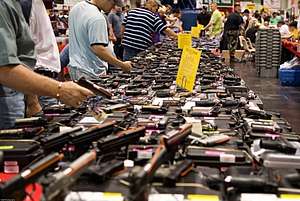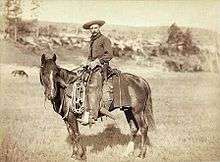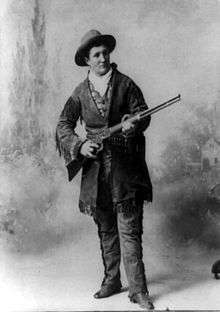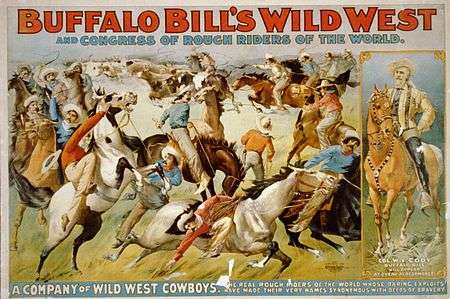Gun culture in the United States
In the United States, gun culture encompasses the behaviors, attitudes, and beliefs about firearms and their usage by civilians. Gun ownership in the United States is the highest in the world, and constitutionally protected by the Second Amendment to the United States Constitution. Firearms are widely used in the United States for self-defense, hunting, and recreational uses, such as target shooting.

Gun politics in the United States tends to be polarized between advocates of gun rights, often conservative, and those who support stricter gun control, often liberal. The gun culture of the United States can be considered unique among developed countries in terms of the large number of firearms owned by civilians, generally permissive regulations, and high levels of gun violence.[1]
History

American attitudes on gun ownership date back to the American Revolutionary War, and also arise from traditions of hunting, militias, and frontier living.[2]
Justifying the unique attitude toward gun ownership in the United States, James Madison wrote in Federalist No. 46, in 1788, that:
Those who are best acquainted with the last successful resistance of this country against the British arms, will be most inclined to deny the possibility of it. Besides the advantage of being armed, which the Americans possess over the people of almost every other nation, the existence of subordinate governments, to which the people are attached, and by which the militia officers are appointed, forms a barrier against the enterprises of ambition, more insurmountable than any which a simple government of any form can admit of. Notwithstanding the military establishments in the several kingdoms of Europe, which are carried as far as the public resources will bear, the governments are afraid to trust the people with arms. And it is not certain, that with this aid alone they would not be able to shake off their yokes. But were the people to possess the additional advantages of local governments chosen by themselves, who could collect the national will and direct the national force, and of officers appointed out of the militia, by these governments, and attached both to them and to the militia, it may be affirmed with the greatest assurance, that the throne of every tyranny in Europe would be speedily overturned in spite of the legions which surround it.[3]

The American hunting/sporting passion comes from a time when the United States was an agrarian, subsistence nation where hunting was a profession for some, an auxiliary source of food for some settlers, and also a deterrence to animal predators. A connection between shooting skills and survival among rural American men was in many cases a necessity and a 'rite of passage' for those entering manhood. Today, hunting survives as a central sentimental component of a gun culture as a way to control animal populations across the country, regardless of modern trends away from subsistence hunting and rural living.[2]
The militia spirit derives from an early American dependence on arms to protect themselves from foreign armies and hostile Native Americans. Survival depended upon everyone being capable of using a weapon. Prior to the American Revolution there was neither budget nor manpower nor government desire to maintain a full-time army. Therefore, the armed citizen-soldier carried the responsibility. Service in militia, including providing one's own ammunition and weapons, was mandatory for all men—just as registering for military service upon turning eighteen is today. Yet, as early as the 1790s, the mandatory universal militia duty gave way to voluntary militia units and a reliance on a regular army. Throughout the 19th century the institution of the civilian militia began to decline.[2]
Closely related to the militia tradition was the frontier tradition with the need for a means of self-protection closely associated with the nineteenth century westward expansion and the American frontier. In popular literature, frontier adventure was most famously told by James Fenimore Cooper, who is credited by Petri Liukkonen with creating the archetype of an 18th-century frontiersman through such novels as The Last of the Mohicans (1826) and The Deerslayer (1840).[4]

Ownership levels

"Americans made up 4 percent of the world's population but owned about 46 percent of the entire global stock of 857 million civilian firearms."[5] U.S civilians own 393 million guns. American civilians own more guns "than those held by civilians in the other top 25 countries combined."[6]
"American civilians own nearly 100 times as many firearms as the U.S. military and nearly 400 times as many as law enforcement."[7] Americans bought more than 2 million guns in May 2018, alone.[7] That is more than twice as many guns, as possessed by every law enforcement agency in the United States put together.[7] In April and May 2018, U.S. civilians bought 4.7 million guns, which is more than all the firearms stockpiled by the United States military.[7] In 2017, Americans bought 25.2 million guns, which is 2.5 million more guns than possessed by every law enforcement agency in the world put together.[7] Between 2012 and 2017, U.S. civilians bought 135 million guns, 2 million more guns than the combined stockpile of all the world's armed forces.[7]
Popular culture
In the late 19th century, cowboy and "Wild West" imagery entered the collective imagination. The first American female superstar, Annie Oakley, was a sharpshooter who toured the country starting in 1885, performing in Buffalo Bill's Wild West show. The cowboy archetype of individualist hero was established largely by Owen Wister in stories and novels, most notably The Virginian (1902), following close on the heels of Theodore Roosevelt's The Winning of the West (1889–1895), a history of the early frontier.[8][9][10] Cowboys were also popularized in turn of the 20th century cinema, notably through such early classics as The Great Train Robbery (1903) and A California Hold Up (1906)—the most commercially successful film of the pre-nickelodeon era.[11]
Gangster films began appearing as early as 1910, but became popular only with the advent of sound in film in the 1930s. The genre was boosted by the events of the prohibition era, such as bootlegging and the St. Valentine's Day Massacre of 1929, the existence of real-life gangsters (e.g., Al Capone) and the rise of contemporary organized crime and escalation of urban violence. These movies flaunted the archetypal exploits of "swaggering, cruel, wily, tough, and law-defying bootleggers and urban gangsters."[12]
With the arrival of World War II, Hollywood produced many morale boosting movies, patriotic rallying cries that affirmed a sense of national purpose. The image of the lone cowboy was replaced in these combat films by stories that emphasized group efforts and the value of individual sacrifices for a larger cause, often featuring a group of men from diverse ethnic backgrounds who were thrown together, tested on the battlefield, and molded into a dedicated fighting unit.[13]
Guns frequently accompanied famous heroes and villains in late 20th-century American films, from the outlaws of Bonnie and Clyde (1967) and The Godfather (1972), to the fictitious law and order avengers like Dirty Harry (1971) and RoboCop (1987). In the 1970s, films portrayed fictitious and exaggerated characters, madmen ostensibly produced by the Vietnam War in films like Taxi Driver (1976) and Apocalypse Now (1979), while other films told stories of fictitious veterans who were supposedly victims of the war and in need of rehabilitation (Coming Home and The Deer Hunter, both 1978).[14] Many action films continue to celebrate the gun toting hero in fantastical settings. At the same time, the negative role of the gun in fictionalized modern urban violence has been explored in films like Boyz n the Hood (1991) and Menace 2 Society (1993).
Political and cultural theories
Gun culture and its effects have been at the center of major debates in the US's public sphere for decades.[15] In his 1970 article "America as a Gun Culture,"[16] historian Richard Hofstadter used the phrase "gun culture" to characterize America as having a long-held affection for guns, embracing and celebrating the association of guns and an overall heritage relating to guns. He also noted that the US "is the only industrial nation in which the possession of rifles, shotguns, and handguns is lawfully prevalent among large numbers of its population". In 1995, political scientist Robert Spitzer said that the modern American gun culture is founded on three factors: the proliferation of firearms since the earliest days of the nation, the connection between personal ownership of weapons and the country's revolutionary and frontier history, and the cultural mythology regarding the gun in the frontier and in modern life.[17] More recently, in 2008, the US Supreme Court affirmed that considerable freedom for individuals to possess firearms is guaranteed by the Second Amendment.[18]
Terms applied to opponents
The terms that gun rights and gun control advocates use to refer to opponents are part of the larger topic of gun politics.
The term gun nut refers to firearms enthusiasts who are deeply involved with the gun culture. It is regarded as a pejorative stereotype cast upon gun owners by gun control advocates as a means of implying that they are fanatical, exhibit abnormal behavior, or are a threat to the safety of others.[19][20][21] Some gun owners embrace the term affectionately.[22]
The term hoplophobia refers to an "irrational aversion to firearms, as opposed to justified apprehension about those who may wield them."[23]
Foreign perspective
The US attitude to guns generally perplexes those in other developed countries, who cannot understand the unusual permissiveness of American gun laws, and why the American public does not push for harsher gun control measures in the face of mass shootings.[24][25] Critics contrast the US reaction to terrorism given how few deaths it causes, with their high death rates from non-terror related gun crime.[26][27] In some countries, such as Brazil, who experienced gun restrictions, the US is a benchmark in gun legislation. [28][29]
See also
- Arming America: The Origins of a National Gun Culture, a discredited 2000 book by historian Michael A. Bellesiles
- Global gun cultures
- Gun control
- Gun ownership
- Gun politics
- Gun show loophole
- Gun violence in the United States
- Index of gun politics articles
References
- Fisher, Max (December 15, 2012). "What makes America's gun culture totally unique in the world, in four charts". Washington Post. Washington D.C. Retrieved January 25, 2014.
- Spitzer, Robert J. (1995). The Politics of Gun Control. Chatham House. ISBN 9781566430227.
- "Federalist No. 46". The Avalon Project. Yale Law School. Retrieved 10 September 2019.
- Liukkonen, Petri. "James Fenimore Cooper". Books and Writers (kirjasto.sci.fi). Finland: Kuusankoski Public Library. Archived from the original on 23 August 2014.
- Christopher Ingraham (June 19, 2018). "There are more guns than people in the United States, according to a new study of global firearm ownership". The Washington Post.
- Edith M. Lederer (June 18, 2018). "Americans Own 46% of the World's 1 Billion Guns, Says U.N. Report". Time. Archived from the original on June 22, 2018. Retrieved January 17, 2019.
- Gutowski, Stephen (June 21, 2018). "Report: Nearly 400 Million Civilian-Owned Guns in America". The Washington Free Beacon. Retrieved January 17, 2019.
- "American Literature: Prose, MSN Encarta". Archived from the original on 2009-10-28.
- "New Perspectives on the West: Theodore Roosevelt, PBS, 2001". Pbs.org. 1919-01-06. Retrieved 2010-11-21.
- Liukkonen, Petri. "Owen Wister". Books and Writers (kirjasto.sci.fi). Finland: Kuusankoski Public Library. Archived from the original on 24 December 2013.
- ""Western Films", Tim Dirks, Filmsite, 1996-2007". Filmsite.org. Retrieved 2010-11-21.
- ""Crime and Gangster Films", Tim Dirks, Filmsite, 1996-2007". Filmsite.org. Retrieved 2010-11-21.
- Digital History, Steven Mintz. "Hollywood as History: Wartime Hollywood, Digital History". Digitalhistory.uh.edu. Archived from the original on 2010-11-29. Retrieved 2010-11-21.
- Digital History, Steven Mintz. "Hollywood as History: The "New" Hollywood, Digital History". Digitalhistory.uh.edu. Archived from the original on 2010-11-29. Retrieved 2010-11-21.
- Cramer, Clayton E. (2009-08-24). Armed America: The Remarkable Story of How and Why Guns Became as American as Apple Pie. Thomas Nelson Inc. ISBN 9781418551872.
- Hofstadter, Richard (October 1970). "America as a Gun Culture". American Heritage Magazine. American Heritage Publishing. 21 (6). Retrieved January 25, 2014.
- Spitzer, Robert J. (1995). The Politics of Gun Control. Chatham House Publishers.
- "US District of Columbia et al v Heller" (PDF). US Supreme Court. June 26, 2008.
- "Shoot-out Confirms Foreign View of America as 'Gun Nut' Country" by T.R. Reid, The Buffalo News, July 26, 1998
- "Small steps on gun control" Los Angeles Times, June 17, 2007
- "'Terror in Capitol' No Surprise to World" By T.R. Reid, Washington Post, July 26, 1998
- The Gun Nut blog at Field & Stream
- Cooper, Jeff (1990). To Ride, Shoot Straight, and Speak the Truth Archived 2013-10-02 at the Wayback Machine. Boulder, Colorado: Paladin Press. pp. 16–19.
- "The world is 'mystified' by America's enduring racism and 'bizarre' gun laws". Business Insider. Retrieved 2016-02-23.
- "The Rest of the First World Is Astounded by America's Enduring Gun Culture". The Wire. Retrieved 2016-02-23.
- Friedman, Uri. "Australian Gun Reformer: 'It's Time to Call Out the U.S.A.'". The Atlantic. Retrieved 2016-02-23.
- "American gun use is out of control. Shouldn't the world intervene?". The Guardian. 2013-09-21. ISSN 0261-3077. Retrieved 2016-02-23.
- Barbosa, Benedito. "(In Portuguese) Vermont is the safest state in the U.S. and even 16 year olds can carry guns there". Cada Minuto.
- Humberto, Cláudio. "(In Portuguese) US has 23 times more weapons. And fewer deaths". Folha de Londrina.
External links
- "Gun Culture". TIME. March 18, 2009.
- Pilkington, Ed (10 January 2011). "US gun crime: death for sale". The Guardian. London.
- DeBrabander, Firmin (2015). Do Guns Make Us Free?: Democracy and the Armed Society. Yale University Press. ASIN: B07CGH7R79